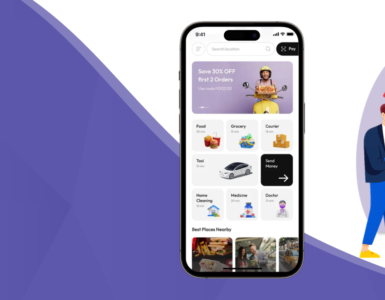Apple continues to be a dominant player in the smartphone industry, making its iOS platform one of the most preferred mobile operating systems globally. Each year, Apple not only upgrades the iOS interface but also elevates the hardware experience. With these changes, iOS app development evolves rapidly to keep up with innovation.
So, what new technologies are shaping the future of iOS apps? And how are developers preparing for these changes? Here’s a look at the latest iOS app development trends that will make a significant impact in 2025 and beyond.
1. Artificial Intelligence: Transforming App Experiences
AI has emerged as a cornerstone in the iOS development ecosystem. With tools like Core ML and enhancements in Siri’s intelligence, iOS developers are now delivering smarter, more predictive apps.
Apps like Starbucks use AI to track previous orders and suggest your next coffee. Finance apps are leveraging AI-powered voice recognition to complete transactions. Siri now integrates even deeper with third-party apps using App Intents, allowing for more natural and context-aware commands.
The integration of AI enhances personalization, productivity, and convenience—qualities users now expect in every iOS app.
2. Create ML and On-device Machine Learning
Building upon Core ML, Create ML allows developers to train custom machine learning models directly on their Macs. Apple’s latest updates support training with private datasets, including image classification, activity recognition, and sound analysis—all without writing a line of code.
This makes it easier for developers to introduce machine learning features like gesture recognition or sentiment analysis into iOS apps while maintaining privacy and performance.
3. Internet of Things (IoT) Integration
From Apple HomeKit to wearable devices like the Apple Watch Ultra 2, IoT has become deeply embedded in the iOS ecosystem. Today, iOS apps can control everything from your lights and thermostats to smart refrigerators.
Developers are now building apps that integrate seamlessly with Matter, the universal smart home standard supported by Apple, Google, and Amazon. This shift will make iOS apps even more important in remote device management, especially in home automation, healthcare, and logistics.
4. Machine Learning: Core ML 4 and Beyond
Apple’s Core ML framework now supports on-device neural network training and improved performance with iOS 17. Developers can build apps with features like real-time object detection, face tracking, and handwriting recognition, without compromising user data privacy.
From medical imaging to personalized shopping assistants, ML will continue to define the next generation of intelligent iOS applications.
5. Enhanced File Management with the Files App
With the Files app now supporting third-party cloud storage like Google Drive and Dropbox, managing files on iOS has become seamless. The app supports tagging, shared folders, and advanced search capabilities, making it ideal for both casual and enterprise users.
This integration makes iOS devices more productive and collaborative, especially for teams working remotely.
6. Augmented Reality: The Rise of VisionOS and ARKit 6
With the launch of Apple Vision Pro and the introduction of visionOS, Apple has doubled down on Augmented Reality. Developers now use ARKit 6 to build immersive experiences that blend the physical and digital worlds.
From AR navigation apps to retail experiences that let you “try before you buy,” AR is becoming a standard expectation in modern iOS apps. Apple’s new tools also support motion capture and instant AR object placement, opening exciting opportunities for gaming, education, and shopping apps.

7. Swift 5.9 and the Rise of SwiftData
Swift remains the core language for iOS development, and with Swift 5.9, developers get even more powerful tools. The release of SwiftData, Apple’s native persistence layer, is simplifying local data storage—making apps faster and easier to build.
Its intuitive syntax and integration with SwiftUI are making Swift the preferred language not just for mobile, but also for macOS, visionOS, and watchOS development.
8. Fortified Security with App Transport Security and Privacy Labels
With growing concerns about data privacy, Apple has mandated App Transport Security (ATS) for all apps. ATS enforces HTTPS connections, ensuring secure data exchanges.
In addition, iOS apps now display Privacy Nutrition Labels on the App Store, showing users what data is collected and how it’s used. Developers need to prioritize end-to-end encryption, secure login APIs, and strong data governance practices.
9. Apple Pay and Tap to Pay on iPhone
Apple Pay adoption is skyrocketing. With Tap to Pay on iPhone, businesses can now accept payments without any extra hardware—just an iPhone. It’s a game-changer for small merchants, service providers, and retail apps.
Apple Pay is also integrated with Safari for seamless checkouts on websites. Developers integrating Apple PayKit make it easy for users to pay for services like flights, hotel bookings, and shopping—securely and effortlessly.
Final Thoughts
The future of iOS app development is defined by AI, AR, secure transactions, and deep device integration. Apple continues to set the bar high with innovations like Vision Pro and SwiftData, while developers leverage these tools to create faster, smarter, and more engaging apps.
With continued investment in privacy, machine learning, and user-centric design, iOS remains the platform of choice for businesses and developers worldwide.
Also, Read Trends That Will Dominate Android App Development Market in 2024 for more Information.
























